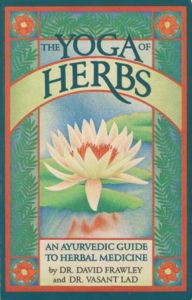
The Yoga of Herbs: an Ayurvedic Guide to Herbal Medicine. by David Frawley and Vasant Lad. Twin Lakes, Wisconsin: Lotus Press, 1986. Illustrations, tables, charts and diagrams, indexes, glossaries, bibliography, sources.
More than any other book since this one was published, The Yoga of Herbs is valuable to the reader trying to understand Ayurvedic medicine within the Western context. Its main objective is to render eastern medicinal knowledge in a format compatible with western herbalism, and can be referred to for its clear and precise presentation of the uses and energetics of herbs. An explanation of the Ayurvedic philosophy of healing is paired with extensive and detailed herbal properties, actions, indications, precautions, and preparations.
The book includes these chapters: Background of Ayurvedic Medicine, Herbal Energetics, Management of Individual Constitution (Doshas), Herbal Therapeutics, How to Prepare and Use Herbs According to Ayurveda, Mantra, Yantra and Meditation, Herbs for Ayurvedic Usage, Appendices, Indexes, Bibliography and Sources. Of immediate interest to the reader who needs an introduction to “… the oldest, most visionary and most developed science of herbal medicine in the world.” p. 1, the first three chapters provide background and portray the vitality of a living philosophy. Complete with physical and meta-physical aspects, the book emphasizes the properties of medicinal herbs and their effects on the human body. So it is the herbal medicine within Ayurvedic medicine that is presented in this review.
Perhaps the most influential chapter, Herbal Energetics, develops herbal medicine as a complex of taste, digestive effect, and energy, which can be heating or cooling. It’s a new concept to many western readers that all substances we ingest have these properties, yet it’s central to the philosophy of herbal medicine. Our bodies have the power to self-heal once a balance of energy is achieved through contact with the energy or potency of plant medicines. This is similar to the digestive effects of food. The special potency of an herb is what distinguishes its ability to promote healing. The six tastes are sweet, sour, bitter, salty, pungent and astringent. To clarify with examples, a sweet taste is experienced with fennel, flaxseed, sesame seed, etc.; salty taste is found in kelp and seaweed. A sour taste is experienced with hawthorn and raspberries, etc., and a bitter taste from chrysanthemum, dandelion, Echinacea and yarrow. The pungent taste is from basil, bay leaves, cardamom, cayenne, cinnamon, cloves, garlic, mustard, peppermint, rosemary, sage, and valerian. And astringent taste is found with pomegranate, mullein, uva-ursi, and white oak bark.
Rather than treat a particular disease, Ayurveda “… brings each individual to their own self-harmony…” p. 37. A bodily constitution, typed according to Ayurvedic tradition, falls into one of three types: Vata, Pitta, or Kapha. The authors claim that acute conditions and superficial syndromes can be treated without typing the constitution. But for chronic diseases, intractable conditions, and the body’s disharmony, an Ayurvedic practitioner is specially trained and experienced to help correct the disharmony and bring about the healing process.
Another aspect of herbal medicine is described in Herbal Therapeutics. Typically in the Western tradition, herbs are classified by their action, sometimes called medicinal effect. For example, an herb called alterative, is selected for help with diseases such as flu, acne, venereal disease, and cancer, because of its ability to cleanse the blood, its bitter or astringent taste, and cooling energy. Herbal actions affect the digestive, circulatory, nervous, respiratory, eliminatory, reproductive, and epithelial organs and are alterative, antiparasitical, astringent, carminative, diuretic, emmenagogues, expectorants, laxatives, stimulants, and tonics. Both English and Sanskrit names, Rakta Shodana karma for alteratives and Bruhana karma for nutritive tonics, are explained in the book’s glossaries.
Herbs for Ayurvedic Use is divided into two parts labeled “Commonly available herbs” and “Special oriental herbs”, those available from Ayurvedic herb suppliers. The reader can evaluate Ginger (Zingiber officinale) for its actions as stimulant, diaphoretic, expectorant, analgesic, and carminative. These actions make the herb good for colds and flu, indigestion, laryngitis, arthritis, and headaches, for example. The section appraises each herb for its parts used, its energetics, the tissues, systems, actions, indications, precautions and preparation. For Ginger, precautions listed are “inflammatory skin diseases, high fever, bleeding, ulcers”. In other words, with signs of heat in the body, Ginger is not the herb to use. Appreciate the hot nature of this herb or food for its help with cold conditions, because “it relieves gas and cramps in the abdomen, including menstrual cramps due to cold” p. 121-122. So with Ginger as a prime example of Ayurvedic philosophy and herbal medicine, indeed Ayurveda views Ginger as a “universal medicine”.
Garlic (Allium sativum) is also classed as heating and pungent. It works on digestive, respiratory, nervous, reproductive, circulatory systems and has alterative, antispasmodic and rejuvenative actions.
Other parts of the book are significant, such as “First Aid Treatments”, p. 224-227, in which antidotes are described: apply a paste of aloe gel and a pinch of turmeric powder for burns. The Appendix contains the Herb Chart, p. 192-223, with herbs listed and labeled for taste, energy and post-digestive effects. It combines the medicinal characteristics and effects on doshas all in tabular format for reference and comparison. Many of the herbs listed are described in detail in the text.
See an explanation of terms and botanical names of the plants from the text of The Yoga of Herbs: an Ayurvedic Guide to Herbal Medicine by David Frawley and Vasant Lad on this page.




[…] last resort of disease, after it has permeated the interior tissues. Reviews of books on TCM and Ayurvedic medicine appear elsewhere on this […]